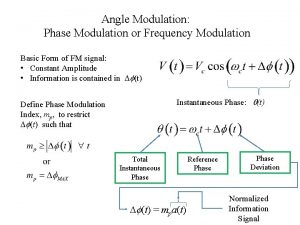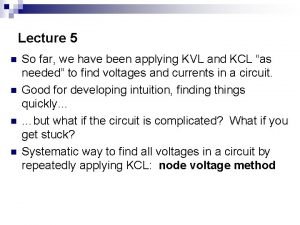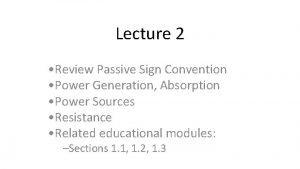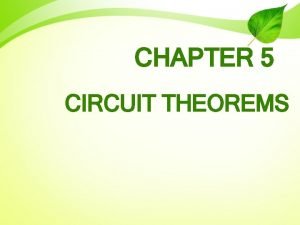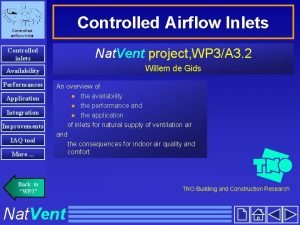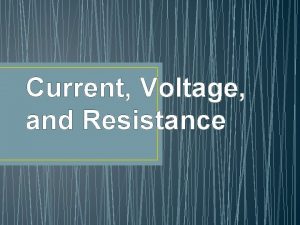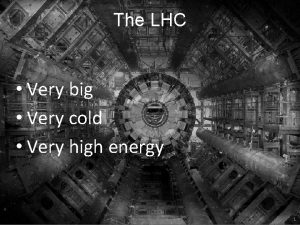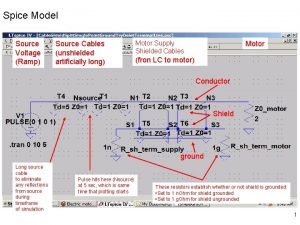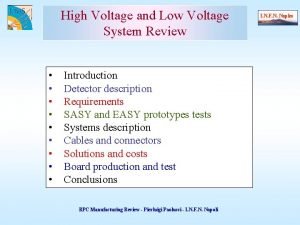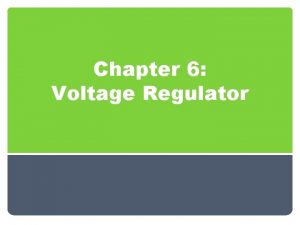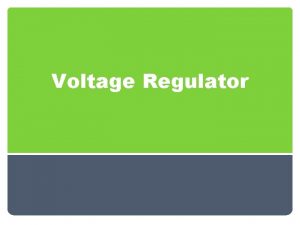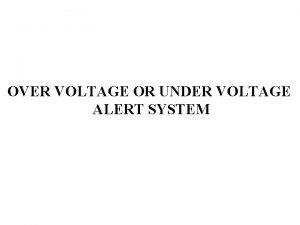Introduction qa voltage controlled voltage source with very


















- Slides: 18


Introduction qa voltage controlled voltage source with very high gain. qfive terminals four ports active element. q. In+Ip+Ic++Ic-+Io=0 Equivalent circuit model of op-amp Vi=Vp-Vn. Ri is the input resistance Ro is the output resistance Vo=AVi=A(Vp-Vn)

Voltage Transfer Curve In reality A, Ri are finite and Ro>0 The output is limited by power source For a 741 op-amp powered with VCC= +10 V and VEE= -10 V, Vo will saturate (reach the maximum output voltage range) at about ± 10 V. With an A=200, 000 V/V saturation occurs with an input differential voltage of 10/200, 000 = 50μV, a very small voltage. How to use it in circuits?

Negative Feedback

Ideal op-amp model Ideal op-amp conditions: Ip=In=0 No current into the terminals Ri=∞ Infinite input resistance Ro=0 Zero output resistance A ∞ Infinite open loop gain Ip=In=0 and Ri=∞ makes no power demands on the input signal source. Ro=0 makes the output voltage independent of the load. Even though the ideal op-amp model deviates much from the real op-amps, the ideal conditions in the ideal op-amp model are very useful in the design and analysis of circuits.

Fundamental Amplifier Configurations (a) Inverting amplifier (c) Differential amplifier (b) Non-inverting amplifier (d) Summing amplifier

Inverting Amplifier— Ideal op-amp circuit analysis Ideal op-amp conditions: Ip=In=0 Ri=∞ Ro=0 A ∞ No current into the terminals Infinite input resistance Zero output resistance Infinite open loop gain

Non-Inverting Amplifier: Ideal op-amp circuit analysis Ideal op-amp conditions: Ip=In=0 Ri=∞ Ro=0 A ∞ No current into the terminals Infinite input resistance Zero output resistance Infinite open loop gain

The Voltage Follower Purpose ?

Inverting Amplifier — Effect of Finite Open-Loop Gain The current through R 1 is now Considering I 1=I 2, the output voltage Vo can thus be determined from

Inverting Amplifier — Effect of Finite Open-Loop Gain Let’s consider an inverting amplifier design with R 1=10 kΩ and R 2=100 kΩ. In this case, the ideal voltage gain is -10. By assuming that A ranges in values from 1, 000 V/V to 10, 000 V/V, Table I shows the real gain and the resulting deviation in % from the ideal case

Non-Inverting Amplifier — Effect of Finite Open-Loop Gain Since In=Ip=0, we have I 1=I 2 and therefore Since the voltage Vi = Vp-Vn = Vin-Vn, the output voltage is given by

Differential Amplifier: Ideal op-amp circuit analysis The output voltage is In order to obtain Vout=0 when Vin 1=Vin 2 only if System is linear and so we may apply superposition Which holds only if The contribution of the signal Vin 2 to the output is The output voltage is now The contribution of the signal Vin 1 to the output is

Real Op-Amp Frequency Response Real Op amps have a frequency dependant open loop gain Where

Real Op-Amp Frequency Response If the open loop bandwidth is so small, how can the op amp be useful?

Real Op-Amp Frequency Response Closed loop band width:

Real Op-Amp Frequency Response

Real Op-Amp Frequency Response Closed loop band width:
 Voltage controlled oscillator
Voltage controlled oscillator Very bad to very good scale
Very bad to very good scale Scientific notation rules
Scientific notation rules There is very few soup in the bowl
There is very few soup in the bowl Is a very shallow skillet with very short sloping sides
Is a very shallow skillet with very short sloping sides Quantifiers of food
Quantifiers of food Marketing controlled information source
Marketing controlled information source High voltage technology
High voltage technology Ac voltage controller output voltage formula
Ac voltage controller output voltage formula Power formula three phase
Power formula three phase Voltage peak to peak to rms
Voltage peak to peak to rms Objective of earthing
Objective of earthing Floating voltage source
Floating voltage source Passive convention
Passive convention Draw the thevenin equivalent circuit
Draw the thevenin equivalent circuit Introduction to low voltage systems
Introduction to low voltage systems Anode cooling chart
Anode cooling chart In 1914, who controlled the shaded areas on the map?
In 1914, who controlled the shaded areas on the map? Controlled variable examples
Controlled variable examples
